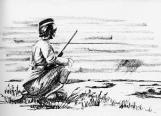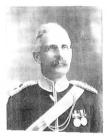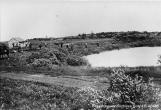1
The second role of the Humboldt Telegraph Station was its military importance in 1885.3
The Humboldt Telegraph Station played a pivotal role in the 1885 battle of Batoche. The Metis, led by Louis Riel, were discontented with John A. MacDonald's Dominion government's handling of their grievances.Both the Metis and the federal government began to assemble forces -
General Frederick Middleton halted at Humboldt on April 13, 1885, on route to Batoche after his troops had marched 124 miles from Fort Qu'Appelle in eight days. This journey... "...included a day's halt, over a bad trail, in worse weather, which was good work for untrained men. We had little or no sickness, plenty of supplies, tea, tobacco, canned meats, bacon, and capital biscuits, called by the men 'hard tack' and the whole force was in good heart."
Excerpt from:
Middleton, Sir Frederick Dobson
1948 Suppression of the Rebellion in the North West Territories of Canada, 1885.
Edited with introduction by G.H. Needler. University of Toronto, Toronto.
5
Middleton's column was permitted to rest at Humboldt. "The few days halt enabled the Grenadiers and Boultons's Scouts to overtake, and be merged in, the main body. The parade-state now showed a strength of about 950 men, made up as follows: artillerymen 183; infantry 617; cavalry and mounted scouts, close upon 150."The troops left Humboldt on April 15 at 7 am after a cold and wet night.
Excerpt from:
Adam, Graeme Mercer
1885 The Canadian North-West: Its History and Troubles, from the Early Days of the Fur Trade to the Era of the Railway and the Settler; with Incidents of Travel in the Region and the Narrative of Three Insurrections. Rose, Toronto.
7
The reinforcements for General Middleton arrive at Humboldt.Sunday, April 26th, around midnight, Colonel George T. Denison receives orders to march to Humboldt at once. He leaves Winnipeg at 4:00 pm on the 27th, after some difficulty finding transport wagons. He reaches the Humboldt Telegraph Station on May 1, 1885.
Denison's instructions were to remain at Humboldt and await further orders.
"There was accumulating by this time at this post a large quantity of food and supplies of all kinds. ..... These stores were in an absolutely indefensible position, and I saw at once that if they were to be guarded they must be moved.
I went out on to the open rolling prairie, and about six hundred yards from the station I found two knolls or bits of rising ground, close together, about eight feet high, with a dip between them. On the higher or larger knoll I pitched my camp and in the dip I placed my picket ropes and fastened my horses, where they would be protected from fire."
"I was on an open rolling prairie, open for miles to the north in the direction of the enemy, who were at Batoche, about fifty-five miles away by the Hoodoo trail. ....I knew that cavalry could not act on the defensive mounted and therefore would be forced to act as infantry.
I began the first night to dig rifle pits to shelter the men; I kept enlarging and connecting them and deepening the ditches in front, until I had a fairly good little earthwork around my tents. ...In a few days I think I could have held my own against a respectable force, if they had no artillery."
Excerpts from Soldiering in Canada: Recollections and Experiences by Lt. Col. George T. Denison.
9
"So affairs went on until about May 8th, when we heard that the General was moving on towards Batoche. On the 9th we received news from the telegraph operator at Clarke's Crossing that they had heard the sound of cannon down the river, in the direction of Batoche, during the day, so we knew that a fight had been going on. I had been sending a patrol out every morning about eight miles to the north, to the Spatinaw (Mount Carmel), a conical hill about two hundred feet high, close to the Hoodoo trail, from which, with powerful field grasses, the men could watch the country for miles.I was asleep in my tent about 4:00 am the next morning, May 10th, when I was awakened by hearing a voice saying to the sentry, "Which is Colonel Denison's tent?" "What news have you from the General?" He lowered his voice so that the sentry would not hear him and said, "Well, it is not good." "What!" said I, "surely he has not been defeated?" "No," he replied, "but he has had a check. He tried to drive the enemy out but could not succeed, and he had fallen back a little way and formed a defense with his wagons, and there they are. Some thought he had better retreat but it was considered that that would have a bad moral effect, and he has determined to stick it out."
He then said, "I want to send off some telegrams at once." The operator was away, trying to mind the line beyond us, but one of my sergeants was an excellent operator, so I wakened him up and we went down to the station. On the side of an old haystack, leaning against the back of the log shanty which constituted Humboldt, with his cypher book before him, Lord Melgund wrote out his dispatches. I walked up and down the grass, and saw the sun rise on a lovely May morning, everything looked beautiful, and I could not help thinking of the anxiety this news would carry to many homes in Manitoba and Ontario."
Excerpts from Soldiering in Canada: Recollections and Experiences by Lt. Col. George T. Denison.
11
"Lord Melgund told me that he was very much averse to leaving the front, but that General Middleton found it necessary to send him, as he had important work for him to do. Just at this serious crisis of the campaign, the telegraph lines were constantly interrupted, and the events were thickening. Lieu.-Colonel Otter had been defeated at Cut Knife on May 2nd, and for four days the General was entrenched about half a mile from the enemy's advanced posts. During this period Humboldt became the end of the telegraph line, and as I was in command there, and the telegraph operator away for some days trying to repair the line from Humboldt to Clarke's Crossing, the whole work had to be done by Sergeant Harry Wilson of the Body Guard, who was an expert operator.It took about two days to get dispatches to the General at Batoche, and a reply back. On May 9th, the first day of the fighting at Batoche, I had sent Trooper Scholfield with dispatches to the General. He got into General Middleton's entrenchment safely, and some hours after he was sent back with a parcel of telegrams to bring to me, and upon his return he reported that he had been fired at four times in getting away. A bullet was afterwards found embedded in his horse's neck.
We were, of course, anxious about the General's position, and I asked Lord Melgund whether we should not bring out all the troops we could hurry up, and march to reinforce our comrades. He advised me to wait, and if I found that at any time I could not get couriers to the camp and receive replies, that then it would be best to telegraph to the Government that, as senior officer near, I was going to order forward all the troops I could reach, and march to relieve the General. Fortunately, I had not to take any responsibility."
Excerpts from Soldiering in Canada: Recollections and Experiences by Lt. Col. George T. Denison.
13
"The first message that I got from the General after Lord Melgund's arrival was to bring up these reinforcements, and to send on to the front by the Hoodoo or Batoche trail as many supplies as I could get teams to take. I managed to get fifty-four teams and sent 110, 000 lbs. of stores up with an escort of thirty-five men, under my brother Captain Clarence Denison. This was a good illustration of the absolute necessity of strictly obeying orders. My orders were to send them by Batoche or Hoodoo trail. As soon as the teamsters heard of it they began to murmur. They came to me and told me they could go by way of Clarke's Crossing and Vermillion Lake and passed Fish Creek with much larger loads and very much faster, and that it would be safer in getting in to the General. I told them I had orders and they must be obeyed if the whole convoy stuck in the mud. My officers came to urge me, and no one could understand why the worst and most dangerous road should be taken, and I think there were considerable doubts for the time as to whether I exercised enough discretion for a commanding officer.The convoy started and before they had gone more than about twenty-three miles it was found that the horses could not possibly draw the loads, so that about twenty-five percent was taken off each wagon and piled around a tent so as to make a barricade, and a small guard of a non-commissioned officer and four men left in charge. The men had named our camp at Humboldt, Fort Denison, and this little post they named Fort Dunn; it existed for some six or seven days. Afterwards I discovered that the General thought it possible that he might have to fall back, and if so he would have been obliged to fall back by this trail, and he very wisely wished to have some food upon it.
Had I disobeyed orders and had it turned out that the General had to retreat, he would have found no food to meet him as he expected, and the convoy would have gone right into the enemy's hands. This is a good example of the necessity of obeying orders, even in details."
Excerpts from Soldiering in Canada: Recollections and Experiences by Lt. Col. George T. Denison.






